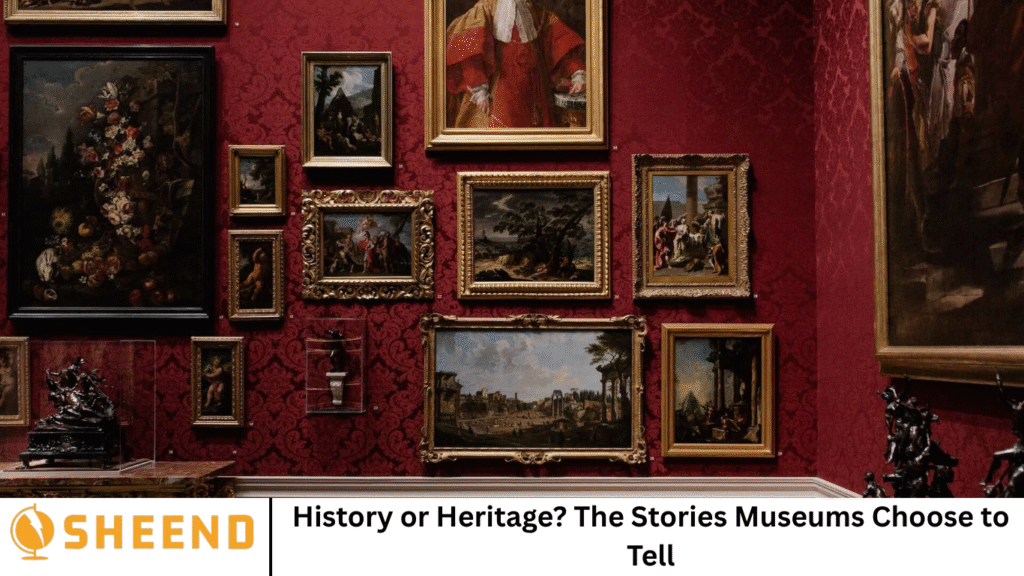Walk into any museum, and you’re stepping into a curated narrative — a version of the past assembled through artifacts, interpretation, and design. But here’s the question: Is it history that museums are telling us, or is it heritage?
The distinction may seem subtle, but it’s profound. History seeks to uncover and explain the past using critical methods and evidence. Heritage, on the other hand, is about identity — it’s the selected parts of history that people or communities choose to preserve and celebrate.
Museums sit at the intersection of these two powerful concepts, often walking a tightrope between objective truth and cultural pride. In this article, we explore how museums around the world navigate this complex terrain, what stories they choose to tell (and omit), and what that means for visitors seeking to understand the past.
More Read: Cultural Comeback: How Communities Rebuild Lost Heritage
Defining the Terms: History vs. Heritage
History
- A scholarly reconstruction of past events.
- Based on evidence, documents, and rigorous analysis.
- Seeks objectivity and truth, even when the past is uncomfortable.
Heritage
- A subjective selection of the past, often rooted in cultural identity.
- Includes traditions, monuments, language, and beliefs passed down.
- Often designed to inspire pride, unity, or belonging.
- While history can challenge our beliefs, heritage usually reinforces them.
Museums: Bridges Between Worlds
Museums are not neutral spaces. Whether national institutions or local historical centers, they play a key role in shaping public understanding.
They often:
- Celebrate cultural heritage, showcasing pride and identity.
- Preserve historical artifacts, giving voice to long-gone eras.
- Educate the public, acting as tools for lifelong learning.
- Influence memory, both personal and collective.
But with great influence comes great responsibility — and complexity.
Case Studies: What Stories Get Told?
The British Museum (London, UK)
Home to global treasures, including the Rosetta Stone and Parthenon Marbles, the British Museum is often at the center of debates about colonial legacy. Is it preserving world history — or appropriating others’ heritage?
National Museum of African American History and Culture (Washington, D.C.)
This museum intertwines both history and heritage to highlight the struggles, triumphs, and cultural contributions of African Americans — reframing American history through a different lens.
The Apartheid Museum (Johannesburg, South Africa)
Here, history confronts heritage head-on. Through documents, testimonies, and photos, it forces visitors to face the brutal truth of institutionalized racism while honoring the resilience of those who resisted it.
The Louvre (Paris, France)
While its art collection spans centuries, the Louvre is often criticized for curating a Western-centric vision of “greatness,” raising questions about whose heritage is spotlighted — and whose is not.
The Politics of Curation
Every exhibit involves choices:
- What items to display.
- How to describe them.
- Whose voice is prioritized.
- What context is offered — or omitted.
A museum may frame a colonial conquest as a military victory, or as cultural theft, depending on its goals and perspective. This makes curation not just educational — but political.
Why Representation Matters
Museums have long marginalized certain voices — Indigenous communities, enslaved people, colonized nations, women, and LGBTQ+ individuals. Slowly, many institutions are acknowledging their biases and working to correct them.
Efforts include:
- Repatriating stolen artifacts to their countries of origin.
- Including community perspectives in exhibit design.
- Highlighting uncomfortable histories such as genocide, slavery, or discrimination.
When museums choose to tell these stories, they transition from being temples of prestige to spaces of justice and healing.
Living Museums: Where Heritage Becomes Interactive
Not all museums are about glass cases and velvet ropes. Living museums — like Colonial Williamsburg or open-air folk museums — immerse visitors in recreated historical settings.
While engaging, these often lean more heavily on heritage, dramatizing history through reenactment. The risk is romanticizing or oversimplifying the past, but the benefit is empathy and personal connection.
Technology and the Future of Museum Storytelling
The digital age is revolutionizing how museums present their narratives:
- Virtual reality lets visitors step inside historical events.
- Augmented reality brings static exhibits to life.
- AI and interactive kiosks personalize learning experiences.
- Crowdsourced exhibits allow communities to contribute their own stories.
These tools offer hope for a more inclusive and participatory model — one where history and heritage aren’t in conflict, but in conversation.
Navigating Controversies: When Stories Clash
Controversy often erupts when historical truth and cultural pride collide.
Examples:
- Debates over Confederate monuments in the U.S.
- Disputes about renaming museums or institutions linked to colonial figures.
- Challenges around restitution of looted cultural objects.
These debates are less about the past — and more about the present. They reveal how museums are battlegrounds for identity, morality, and memory.
The Role of the Visitor
Visitors aren’t just passive consumers of museum narratives. Their engagement, questions, and feedback shape future exhibits. By approaching museums critically, we become co-curators of meaning.
Ask yourself:
- Who is telling this story?
- Whose voice is missing?
- What emotions does this evoke in me — and why?
The more mindful we are, the more museums become spaces of growth, not just nostalgia.
Frequently Asked Question
What’s the difference between history and heritage in a museum context?
History is rooted in evidence-based research, aiming for objective truth. Heritage is a more emotional, cultural expression of the past, often selected for identity or pride. Museums often blend both to shape their exhibits.
Why do some museums face criticism over their exhibits?
Criticism often stems from bias, omission, or glorification of problematic histories. Museums may ignore certain voices or perpetuate colonial narratives, prompting calls for change, repatriation, and more inclusive storytelling.
What are examples of museums telling heritage-focused stories?
Ethnic, religious, and community-based museums — like Jewish museums, Indigenous heritage centers, or folk art museums — often focus on preserving and celebrating cultural identity, leaning more toward heritage than history.
Can a museum ever be completely objective?
No. Every museum exhibit reflects curatorial choices — what to include, exclude, and emphasize. While they can strive for balance, complete objectivity is difficult. Transparency and inclusivity are key to credibility.
How are modern museums becoming more inclusive?
Through community involvement, diverse hiring, repatriation of artifacts, confronting uncomfortable histories, and using digital tools to engage broader audiences. Inclusion is now central to many museums’ missions.
What is a living museum?
A living museum recreates historical settings and daily life through actors, buildings, and demonstrations. These immersive experiences prioritize engagement and heritage but must be careful not to romanticize or distort history.
How can visitors critically engage with museum exhibits?
By asking whose stories are being told, recognizing biases, seeking out alternative sources, and participating in discussions or feedback opportunities. Visitors who think critically can influence future museum narratives.
Conclusion
Museums are more than quiet halls of artifacts — they are vibrant, living storytellers shaping how we understand ourselves, each other, and the past we inherit. The line between history and heritage is often blurred, not because one is better than the other, but because both are essential to a complete human experience. History challenges us to confront facts, often uncomfortable ones. Heritage offers connection, pride, and belonging. When museums acknowledge this duality, they move beyond simple preservation and become spaces of transformation — where truths are told, cultures are honored, and new perspectives are born.


